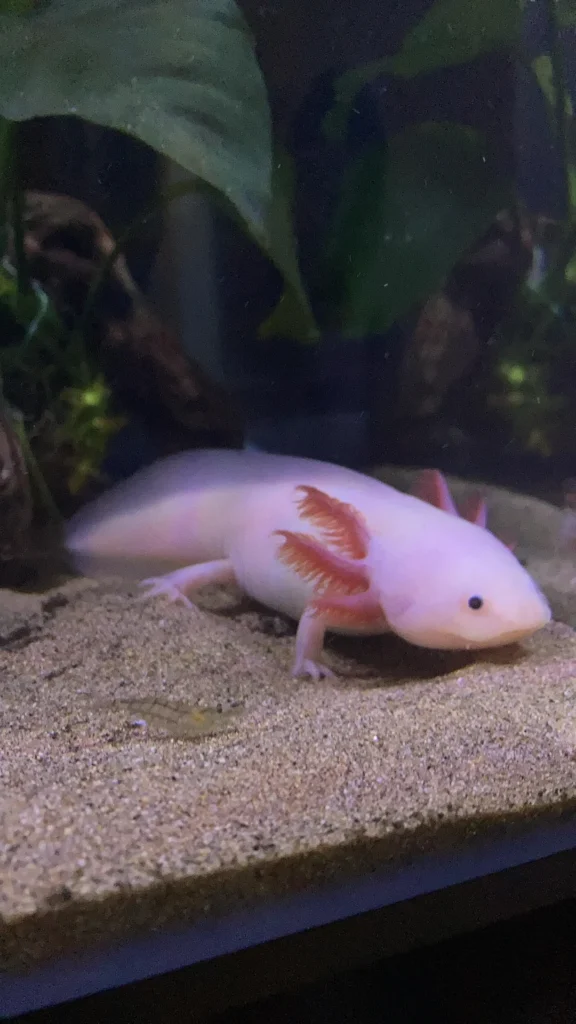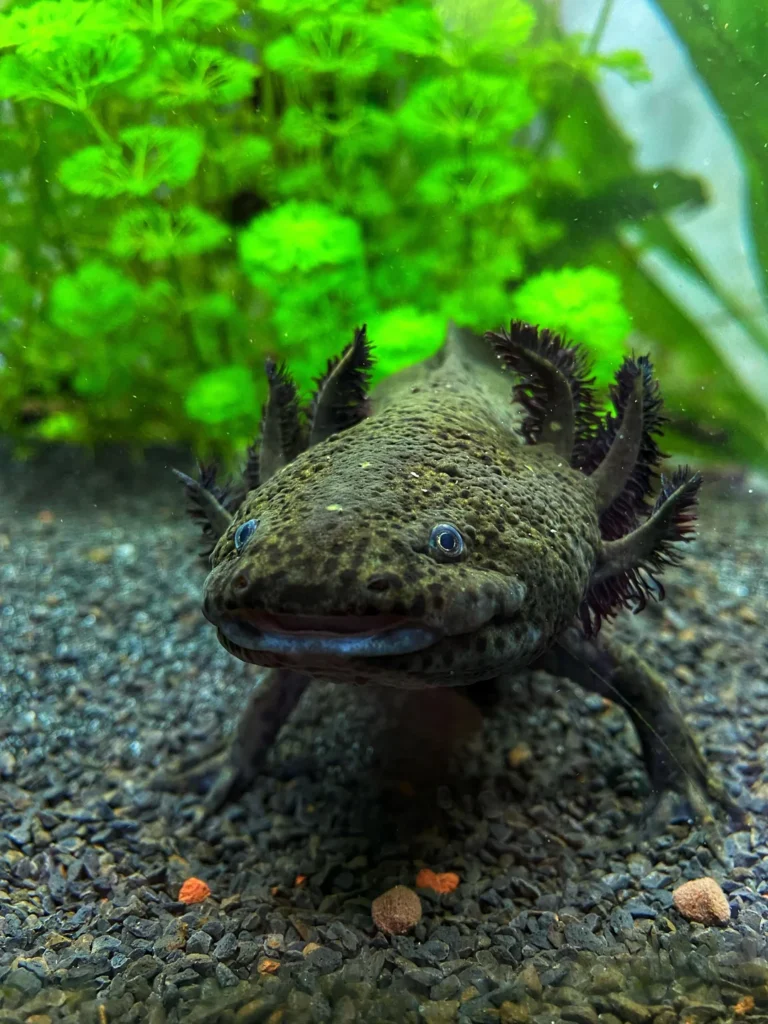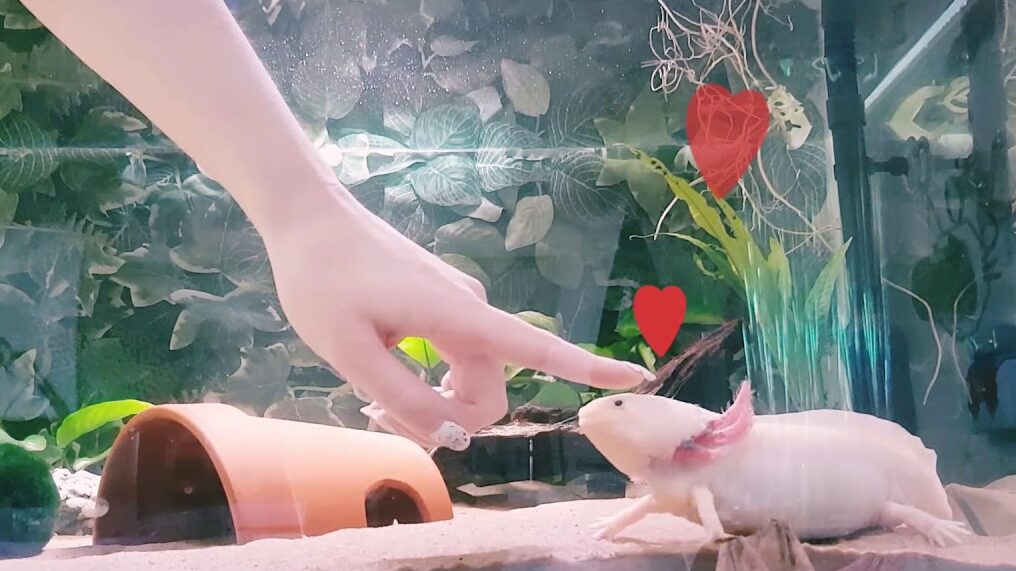
Axolotls are unique and fascinating aquatic creatures that require specific care to thrive in captivity. One crucial aspect of their habitat is the substrate or bedding you choose for their tank. In this article, we’ll explore the various types of sand and their suitability for axolotls, along with important considerations and frequently asked questions.
Which Sand is Best for Axolotls?
Selecting the ideal substrate for your axolotl tank is crucial to their health and well-being. But with so many options available, it can be overwhelming. So, which sand is best for axolotls? Let’s delve into the factors that matter.
When it comes to axolotl substrates, there’s no one-size-fits-all answer. The choice largely depends on your axolotls’ preferences and your tank setup. However, there are a few key considerations to keep in mind.
First, axolotls have delicate skin, so you’ll want to avoid abrasive or sharp substrates. This rules out options like coarse gravel or rough sand. Instead, opt for soft and fine-grained sand that won’t cause harm or irritation to your pets.
Another factor to consider is the ease of maintenance. Cleaning your tank should be hassle-free, and some substrates make this task easier than others. Pool filter sand, for instance, is known for its uniformity and ease of cleaning.
Moreover, think about the aesthetic aspect. Black sand can lend a sleek and captivating look to your axolotl habitat. On the other hand, play sand can create a more natural and beach-like environment.
Ultimately, your choice of sand should also consider water chemistry. Some sands, like aragonite sand, can affect the pH of your tank water. This can be beneficial or problematic depending on your specific needs.
Types of Sand for Axolotls
Now that we’ve touched on the factors to consider when choosing sand for your axolotls, let’s explore the various types of sand available:
- Black Sand: Black sand is favored for its striking appearance, resembling the depths of a dark riverbed. It adds a touch of elegance to your axolotl tank and is typically soft, making it suitable for your pets.
- Pool Filter Sand: This type of sand is known for its uniformity, which makes it easy to clean. It’s an affordable option that many axolotl keepers appreciate for its simplicity.
- Play Sand: If you want to replicate a natural, beach-like environment, play sand might be the way to go. It’s soft and fine-grained, offering a comfortable surface for your axolotls to explore.
- Aragonite Sand: Aragonite sand can impact your tank’s pH level, making it more alkaline. This can be advantageous if you’re looking to stabilize pH, but it requires careful monitoring.
Each type of sand has its advantages and disadvantages, so it’s essential to align your choice with your axolotls’ needs and your personal preferences. Remember, your axolotls will spend most of their lives on this substrate, so their comfort should be a top priority.
Black Sand for Axolotls
Black sand is an intriguing option when it comes to choosing a substrate for your axolotl tank. Its deep, dark color can create a stunning and captivating underwater landscape that contrasts beautifully with your axolotls’ pale and unique appearance. However, like any substrate, black sand has its own set of pros and cons to consider.
Pros of Using Black Sand
- Enhanced Aesthetics: One of the standout benefits of using black sand is the aesthetic appeal it brings to your axolotl tank. The rich, dark color creates a dramatic backdrop that makes your axolotls stand out, making it a popular choice among enthusiasts who want to showcase their pets in style.
- Natural Look: Black sand can simulate the look of the axolotls’ natural habitat, such as muddy riverbeds and dark, still waters. This can provide a sense of security and comfort to your axolotls, potentially reducing stress and encouraging natural behaviors.
Cons of Using Black Sand
- Potential Abrasiveness: One of the primary concerns with black sand is its texture. It tends to be finer than other substrates, but the particles can be abrasive if not properly maintained. Axolotls may accidentally ingest sand while hunting for food, which can be harmful to their delicate digestive systems.
- Maintaining Water Quality: Black sand can trap debris and waste more readily than coarser substrates. This means you’ll need to be vigilant about regular cleaning to prevent ammonia spikes and other water quality issues. Using a gravel vacuum during water changes can help address this concern.
Pool Filter Sand for Axolotls
Pool filter sand is a popular choice among axolotl enthusiasts as a substrate for their tanks. This type of sand, designed for use in swimming pool filtration systems, offers a range of benefits and considerations worth exploring to determine if it’s the right fit for your axolotl habitat.
Choosing an appropriate substrate, like pool filter sand, is crucial for mosaic axolotls and Piebald Axolotls. Pool filter sand is fine-grained and safe, minimizing the risk of impaction. It also promotes a clean environment and is easy to clean, contributing to the overall well-being and happiness of these unique aquatic beings.
Benefits of Pool Filter Sand
- Affordability: One of the most significant advantages of pool filter sand is its cost-effectiveness. It’s typically available at a lower price point than many other aquarium substrates, making it an appealing option for budget-conscious axolotl keepers.
- Uniformity: Pool filter sand is known for its consistency in particle size and texture. This uniformity makes it easy to work with and creates a smooth substrate surface in your axolotl tank.
- Ease of Cleaning: Cleaning your axolotl tank is a crucial part of maintenance, and pool filter sand simplifies this process. Its fine grains allow debris to settle on the surface, making it easier to vacuum and maintain water quality.
Considerations When Using Pool Filter Sand
- Silt and Cloudiness: One potential drawback of pool filter sand is that it can produce silt and make the water appear cloudy, especially when initially added to the tank. Regular water changes and proper rinsing of the sand before use can help alleviate this issue.
- Buffering Capacity: Pool filter sand may have some impact on your tank’s water chemistry. It has a slight buffering effect, which means it can raise the pH level over time. This may be beneficial if your water is naturally acidic, but it’s essential to monitor pH levels regularly, especially if you have sensitive aquatic plants or other tank inhabitants.
Play Sand for Axolotls
Play sand is a substrate choice that evokes a natural and beach-like environment for your axolotls. It’s a fine-grained, soft sand that appeals to many axolotl enthusiasts due to its unique benefits and considerations. Let’s dive into why play sand is an option worth considering for your axolotl tank.
Advantages of Play Sand
- Soft Texture: Play sand is exceptionally gentle on your axolotls’ delicate underbellies. Axolotls are known to spend a lot of time resting on the substrate, and the soft texture of play sand provides a comfortable surface for them to lounge on.
- Budget-Friendly: If you’re looking to create an appealing habitat for your axolotls without breaking the bank, play sand is a cost-effective option. It’s readily available at most home improvement stores, making it an accessible choice for budget-conscious aquarists.
- Natural Appearance: Play sand mimics the appearance of sandy riverbanks or lake bottoms, replicating the axolotls’ natural habitat. This can create a visually appealing and calming environment for both your axolotls and yourself.
Challenges of Using Play Sand
- Compaction Concerns: Play sand is quite fine and can become compacted over time, potentially creating hard spots. To prevent this, consider regularly fluffing and aerating the sand with a gentle stir to maintain its soft, comfortable texture.
- Maintaining Water Clarity: Play sand can be prone to stirring up debris when disturbed. While it’s not a major concern, you may need to put in extra effort to maintain water clarity by employing effective filtration and regular water changes.
Aragonite Sand for Axolotls
Aragonite sand is a unique substrate option that offers distinct benefits for axolotl keepers. While it may not be the most common choice, understanding its advantages can help you decide whether it’s the right fit for your axolotl habitat.
Aragonite Sand Benefits
- pH Buffering: One of the standout advantages of using aragonite sand is its ability to act as a natural pH buffer. Aragonite is a calcium carbonate-based material that can help stabilize and elevate the pH level in your axolotl tank. This can be particularly useful if your water source is naturally acidic, as axolotls generally prefer a slightly alkaline environment. Maintaining a stable pH level is crucial for the overall health and well-being of your axolotls.
- Calcium Supply: Aragonite sand also provides a source of calcium, an essential mineral for axolotls. Calcium plays a vital role in their bone and exoskeleton development. By using aragonite sand, you can ensure a steady supply of calcium in the water, promoting healthy growth and bone maintenance for your axolotls.
It’s important to note that while aragonite sand offers these benefits, it also comes with considerations. One of the primary considerations is its potential to elevate the pH level significantly. If your water source already has a high pH, using aragonite sand might not be advisable, as it can push the pH to levels that are less suitable for axolotls.
How Much Sand is Enough for Axolotl Tank?

Determining the appropriate depth of sand in your axolotl tank is a crucial aspect of creating a comfortable and safe environment for these unique aquatic creatures. Axolotls are known for their bottom-dwelling behavior, and the amount of substrate you provide can significantly impact their well-being.
Ensuring “Safe Water for Axolotl,” using the Best Filters for Axolotl Tanks, includes determining the appropriate amount of sand for their tank. For optimal comfort and natural behaviors, aim for a substrate depth of around 1-1.5 inches. This depth allows axolotls to explore and burrow while minimizing the risk of impaction.
Ideal Depth of Sand
The ideal depth of sand in an axolotl tank is generally considered to be around 1 to 1.5 inches (2.5 to 3.8 cm). This depth allows axolotls to perform their natural behaviors comfortably, such as burrowing and exploring the substrate. Here are some key reasons for this depth recommendation:
- Comfortable Burrowing: Axolotls have a natural inclination to burrow in the substrate, especially when they feel stressed or during their rest periods. A depth of 1 to 1.5 inches provides them with enough sand to engage in this behavior without feeling cramped.
- Thermal Stability: Maintaining a consistent water temperature is essential for axolotls. A shallow layer of sand helps insulate the tank bottom, preventing temperature fluctuations and ensuring the axolotls are comfortable in their environment.
- Ease of Maintenance: A modest depth of sand is easier to clean and maintain. It allows for efficient removal of waste and debris during water changes, ensuring good water quality and reducing the risk of ammonia spikes.
- Safety: A shallower layer of sand minimizes the risk of your axolotls ingesting large amounts of sand accidentally, which can be harmful to their digestive system.
While 1 to 1.5 inches is considered ideal, it’s important to note that some axolotls may have individual preferences. Some may prefer a bit more or less sand for burrowing. Regularly observing your axolotls and their behavior can help you adjust the sand depth to their comfort.
FAQs
1. Can I use regular beach sand for axolotls?
Answer: No, it’s not recommended. Beach sand may contain harmful contaminants and isn’t ideal for axolotl tanks.
2. Is sand safe for baby axolotls?
Answer: Yes, but you should choose a fine, soft sand to avoid potential harm to young axolotls.
3. How often should I clean sand in my axolotl tank?
Answer: Regularly vacuuming the surface of the sand during water changes is advisable to remove waste and maintain water quality.
4. Can axolotls ingest sand, and is it harmful?
Answer: Axolotls may accidentally ingest sand while feeding, but if the sand is of the right type and size, it’s usually not harmful in small quantities.
5. Should I add any supplements when using sand?
Answer: Depending on the sand type, you may need to monitor water parameters and adjust accordingly, especially when using aragonite sand.
6. Is it necessary to have sand in an axolotl tank?
Answer: While sand isn’t mandatory, it can provide a more natural environment for axolotls and help with their comfort and substrate-related behaviors.
7. Can I mix different types of sand in the tank?
Answer: Mixing sand types can be done, but it’s essential to consider the compatibility of sand types and their impact on water chemistry.
8. How can I prevent sand from getting sucked into the filter?
Answer: Using a pre-filter or sponge over the intake of the filter can help prevent sand from clogging the system.
9. Do I need to sterilize sand before adding it to the tank?
Answer: Sterilizing sand by rinsing it thoroughly with dechlorinated water is recommended to remove any impurities.
10. Can axolotls burrow in sand?
Answer: Yes, axolotls are known to burrow in sand, especially when they feel stressed or during rest periods.
Conclusion
In conclusion, selecting the right substrate for your axolotl tank is a critical decision that can significantly impact the well-being and comfort of your aquatic companions. Each type of sand, from the visually striking black sand to the budget-friendly pool filter sand, and the natural appeal of play sand to the pH-stabilizing aragonite sand, offers unique advantages and considerations.
Black sand lends an air of elegance to your tank but requires careful attention to prevent abrasion. Pool filter sand offers affordability and uniformity but may present some challenges in maintaining water clarity. Play sand provides a soft, natural appearance but may compact over time, requiring periodic aeration. Aragonite sand, with its pH-buffering properties and calcium supply, can be an excellent choice for those seeking to stabilize water conditions.
With 3 years of devoted companionship alongside my aquatic friend, Bob, I’ve gained profound insights into the captivating world of fishkeeping. From understanding behavior to ensuring optimal health, my journey with Bob has enriched my expertise in all things aquatic.




Pingback: White Albino Axolotls: A Complete Guide - Fish Hue
Pingback: Do Axolotl Change Color - Fish Hue